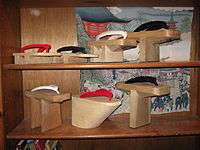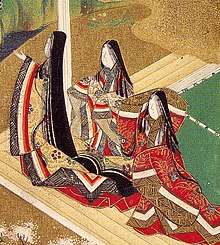Geta (footwear)
Geta (下駄) are a form of traditional Japanese footwear that resemble clogs and flip-flops. They are a kind of sandal with an elevated wooden base held onto the foot with a fabric thong to keep the foot well above the ground.
History
Oiran (花魁), who were high-ranking courtesans of the feudal period in Japan, wore tall, lacquered koma-geta or mitsu-ashi (literally, "three legs"). Whereas geisha and maiko wear tabi socks, the oiran and tayū preferred not to do so (even in winter) and their toes can be seen poking out under many layers of kimono while wearing these tall geta. These shoes were most likely worn to ensure there was no confusion between geisha, maiko and oiran / tayū. One sometimes sees maiko hobbling along in okobo, but the pace must have been even more arduous in these tall geta.
Merchants used very high geta (two long teeth) to keep the feet well above the seafood scraps on the floor
Use
Geta are primarily worn with yukata, but sometimes also with Western clothing during the summer months. As geta are usually worn only with yukata or other informal Japanese clothes or Western clothes, there is no need to wear socks. Ordinarily, people wear slightly more formal zōri when wearing tabi.
In weather
Sometimes geta are worn in rain to keep the feet dry, due to their extra height and impermeability compared to other footwear such as zōri. They make a similar noise to flip-flops slapping against the heel whilst walking. When worn on water or dirt, flip-flops may flip dirt or water up the back of the legs. This does not tend to happen with the heavier Japanese geta.
Geta are not normally worn in snow, because snow often gets stuck to the teeth of the geta, making it difficult to walk. However, in historical times, they were worn in the snow.
.jpg)
Styles
There are several different styles of geta. The most familiar style consists of an unfinished wooden board called a dai (台, stand) that the foot is set upon, with a hanao (鼻緒, cloth thong) that passes between the big toe and second toe.
The two supporting pieces below the base board, called ha (歯, teeth), are also made of wood, usually very light-weight kiri (桐, paulownia) and make a distinctive "clacking" sound while walking: karankoron (カランコロン). This is sometimes mentioned as one of the sounds that older Japanese miss most in modern life. A traditional saying in Japanese translates as "You don't know until you have worn geta." This means roughly, "you can't tell the results until the game is over."
The original motivation for wearing the high platform shoes was not fashion, but practical: to keep feet from coming in contact with things on the ground, e.g. dirt, filth, water, or snow.
The dai may vary in shape: oval ("more feminine") to rectangular ("more masculine") and color (natural, lacquered, or stained). The ha may also vary in style; for example, tengu-geta have only a single centered "tooth". There are also less common geta with three teeth.
Geisha
Maiko (geisha in training) wear distinctive tall geta called okobo which are similar to the chopines worn in Venice during the Renaissance. Also very young girls wear okobo, also called "pokkuri" and "koppori", that have a small bell inside a cavity in the thick "sole". These geta have no "teeth" but are formed of one piece of wood. The middle part is carved out from below and the front is sloped to accommodate for walking. Pokkuri are usually red in color and are not worn with yukata, but a very fancy kimono (such as at shichi-go-san festivals). Okobo are usually worn with tabi.
Construction
Geta are made of one piece of solid wood forming the sole and two wooden blocks underneath. These blocks may have a metal plate on the section that touches the ground in order to lengthen the life span of the geta. A V-shaped thong of cloth forms the upper part of the sandal.
The teeth are usually not separate, instead, the geta is carved from one block of wood. The tengu tooth is, however, strengthened by a special attachment. The teeth of any geta may have harder wood drilled into the bottom to avoid splitting, and the soles of the teeth may have rubber soles glued onto them.
The hanao can be wide and padded, or narrow and hard, and it can be made with many sorts of fabric. Printed cotton with traditional Japanese motifs is popular, but there are also geta with vinyl and leather hanao. Inside the hanao is a cord (recently synthetic, but traditionally hemp) that is knotted in a special way to the three holes of the dai. In the wide hanao there is some padding as well. The hanao are replaceable. It sits between the two first toes because having the thong of rectangular geta anywhere but the middle would result in the inner back corners of the geta colliding when walking. Recently, as Western shoes have become more popular, more Western looking geta have been developed. They are more round in shape, may have an ergonomically shaped dai, a thick heel as in Western clogs, instead of separate teeth, and the thong at the side as in flip-flops. According to Japanese superstition, breaking the thong on one's geta is considered very unlucky.[1]

See also
References
- Greve, Gabi (2016-06-10). "Edo - the EDOPEDIA -: geta wooden clogs". Edo - the EDOPEDIA -. Retrieved 2019-02-21.
| Wikimedia Commons has media related to Geta. |
| Look up geta in Wiktionary, the free dictionary. |
- Edo - the EDOPEDIA: geta wooden clogs
- Wafuku blog about geta Names and descriptions of all the types of Japanese geta, with photos.
- Japan Footwear Museum(in Japanese)
- The history of Japanese Geta Sandals
